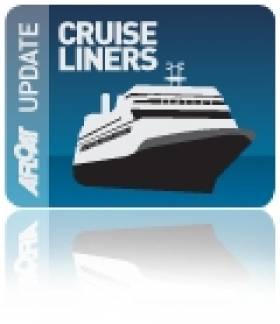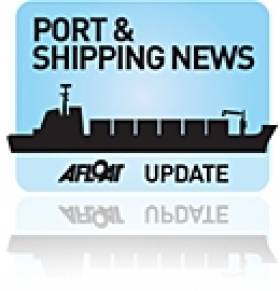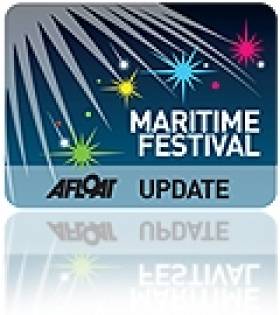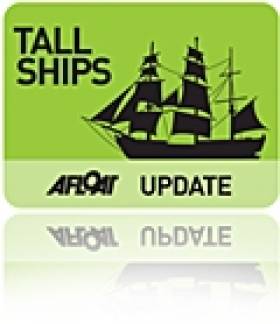Displaying items by tag: Guinness
#Guinness - An heir to the Guinness dynasty fortune is under investigation after an incident in which his boat sank in Lake Como in Italy.
Motorboat & Yachting reports that Edward Guinness is believed to have been at the helm of the boat when it hit a rock wall and sank close to dock in the early hours of Sunday 3 May, forcing all on board to swim to safety.
Guinness, a London-based fund manager and descendant of the family that established the famous St James's Gate brewery, was among five of the 10 people on board who were hospitalised with "serious" injuries.
According to the Guardian, the boat was carrying a group of British and Spanish tourists near the Guinness family residence at Villa Lucertola.
Prosecutor Pasquale Addesso said the investigation will look into alcohol played a role in the accident. The Guardian has more HERE.
#CruiseShips- A mini-luxury cruiseship Sea Explorer docked in Dun Laoghaire Harbour today, fortunately without passengers on board, as a very unseasonable Dublin Bay was battered by a heavy snow squall, writes Jehan Ashmore.
As the Sea Explorer approached Dun Laoghaire Harbour, the pilot cutter 'Liffey' which set out from Dublin Port came alongside to transfer a pilot aboard the 4,200 tonne vessel which was arriving on a passage from Cadiz.
Sea Explorer which has a passenger capacity for 116 passengers is to remain moored in the harbour albeit in a 'lay-up' mode in advance to taking up a European season with cruises starting in June from a temporary 'homeport'.
It is the norm for cruiseships to reposition between seasons and operating regions around the world, such as the Caribbean and Mediterranean and relocate to a designated homeport.
As previously reported on Afloat.ie, Dun Laoghaire Harbour is expected to receive up to 14 cruise calls this season, including the highlight call of Cunard Line's flagship liner 'QM2' on 16 May.
Also reported was yesterday's launch of the National Ports Policy where Minister for Transport, Leo Varadkar announced that Dun Laoghaire Harbour along with four other ports were classed as having 'regional significance'.
In the case of Dun Laoghaire Harbour, the development of the port is to be in line with local requirements focusing on tourism, cruise liners and marine leisure activity.
The ports are to be transferred to the control of local authorities in a move that will require legislation which may take up to 18 months to complete.
Meanwhile, Sea Explorer will be sharing the same quayside at the ferry terminal with the new Dublin Bay Cruises excursion vessel, St. Bridget.
On the adjacent berth is another vessel with a similar name to the cruiseship, that being the HSS Stena Explorer which operates the seasonal-only fast-craft ferry service to Holyhead.
Finally, the port has also been engaged in a return to cargsoships with the third batch of Guinness fermentation tanks, which were discharged from the Blue Tune on Monday. This final batch are bound for the St. James's Gate Brewery plant in Dublin.
Tanks for Guinness Arrive in Dun Laoghaire Harbour
#DunLaoghaire – Last night the Dutch-flagged Myrte (6,120 tonnes) docked in Dun Laoghaire Harbour loaded with fermentation tanks bound for Guinness, writes Jehan Ashmore.
The 10 X 30 tons fermentation tanks are to be discharged during the week and installed in Diageo's Guinness (St. James Gate) plant. The historic city-centre brewery's fermentation plant is to be refurbished as part of a major investment.
The 122m cargoship berthed alongside the former conventional ferry (mail) boat Carlisle Pier, from where the cargo will be taken by road convoy, but travelling overnight to avoid traffic and minimise disruption.
This delivery is part of a 'project' cargo as a further two shipments are scheduled, however it has been many years since cargoships have called to Dun Laoghaire Harbour.
In the late 1980's/early 90's there were relatively frequent calls undertaken by 'reefer' ships, vessels equipped with refrigeration capability carrying perishable products.
Some vessels were instead of the ro-ro design, this allowed refrigerated freight-trailers to be driven onboard the ship which berthed at the port's ferry ramp linkspan.
#QUEENS RIVER PAGEANT – The oldest operating tallship in Europe, Belem built in 1896 and once owned by the family of the Guinness brewing dynasty, is to take pride of place in Queen Elizabeth's Diamond Jubilee River Pageant on the Thames tomorrow, writes Jehan Ashmore.
An estimated 1 million people are expected to witness the Queen on the Royal barge as its heads downriver through London. The historic occasion will be one of the most impressive parades ever staged on the river, which sets off from Battersea to Tower Bridge.
Accompanying the royal barge will be an extensive flotilla of more than a thousand vessels representing craft of all shapes and sizes gathered together from the UK and Commonwealth. The flotilla will pass through an avenue of sails and a gun salute will mark the spectacle which starts at 2pm and is scheduled to take four hours to complete.
Belem's prominence in the entourage stems from the eve of World War I, where the French cargo ship ended her days when handed over for the first time under the UK flag. Belem became the property of Duke of Westminster who had her totally refurbished and turned into a luxury yacht for 40 guests.
She was sold to Sir Arther Ernest Guinness in 1921 and renamed Fantôme II. The affinity to which he showed to the yacht was so strong that a small deckhouse office was built as an extension of the original, so that business could continue at sea, which included a round the world voyage.
Before her current owners the Belem Foundation, she was used as an Italian sail-training ship under the name Giorgio Cini after WWII until 1965 and in which she continues in such a role to the present day. The vessel will pay homage during the parade, to recognise the preservation of the vessel and the 'Entente Cordiale'. Her historical significance is also recognised as the French government classified her as a historical monument.
In 2010 she was chartered to make a special voyage to Dublin to celebrate the 50th Anniversary of Alliance Française in the capital. During a four-day visit, Bastille Day was celebrated while moored close to the National Convention Centre for the inaugural French Market.
Not forgetting that during her original career as a cargoship which included nearly two decades crossing the Atlantic to the north Brazilian port of Belem. She carried a diverse range of cargo including cocoa beans that were carried along the Seine for a Paris-based chocolate-maker.
Her cargo-carrying career returned in recent years which included a symbolic small consignment of wine to Dublin followed by larger commercial cargo from Bordeaux to Montreal in the Canadian French speaking province of Quebec.
Fond Memories of Guinness Barges on the Liffey
#INLAND WATERWAYS - As Derek Evans writes in The Irish Times, the recent discovery of the first Guinness merchant vessel - sunk a century ago by a German torpedo in the Irish Sea - rekindled memories of the brewery's boats on the Liffey in the 1950s.
He writes: "Living close to Stoneybatter, I often took time to stand on Queen Street Bridge as the barges, filled with Guinness barrels, slowly made their way from James’s Gate to Sir John Rogerson’s Quay.
"I remember clearly the skipper standing beside the open wheelhouse in his navy blue polo-neck jumper, captain’s hat and pipe... The skipper always had a smile and a wave before he would disappear for a few moments under the white cloud."
He also recalls the hoisting of the barrells at Butt Bridge onto the Guinness cargo vessels - like the WM Barkley, the Lady Grania or Gwendolen Guinness - for transport to Liverpool.
As previously reported on Afloat.ie, the wreck of the WM Barkley was captured in high-resolution images taken from the national research vessel RV Celtic Voyager off the coast of Dublin.
The Irish Times has more on the story HERE.
Arthur's Day: Time to Reflect the Last Guinness Ships
The Lady Patricia represented the last of the more traditional Guinness vessels, though her predecessors The Lady Grania and The Lady Gwendolen differred in that they had split superstructures with the bridge admidships and accommodation quarters placed aft. Whereas The Lady Patricia had her superstructure positioned well aft.
In addition she was the last to carry a 'Lady' prefix name. She was named after the daughter of Lord Iveagh, Rupert Guinness, when entering service in 1962 from the yard of Charles Hill & Sons, Bristol. Her entry allowed the Guinness to be eventually replaced when she went to be scrapped at Faslane the following year.
Two deck-mounted granes that were used to hoist silver cylinders containing the beer where removed in 1973 from The Lady Patricia when she was converted into the world's first beer-tanker. The new method no longer required the cumbersome and time-consuming process of loading barrels from trucks. Instead trucks fitted with tanks transferred the liquid-cargo through pipes which involved pumped some 205,000 gallons or 1.87 million pints on board.
Unlike The Lady Patricia which was converted for tanker operations, the Miranda Guinness became the world's first custom-built beer-tanker when launched in 1976 from the Albion Shipyard also in Bristol. She also represented the last vessel to be launched (see PHOTO) there, after 156 years of shipbuilding.
Miranda Guinness was named by the Countess of Iveagh, after whom she was named. The newbuild replaced both The Lady Grania and The Lady Gwendolen which were sold. Since their launch The Lady Patricia and Miranda Guinness were registered in Liverpool until 1987 when the port of registry became Dublin. This arose following a change in the vessels management to Irish Marine Services Ltd, which was made up of former Irish Shipping Ltd management.
This arrangement only lasted to 1993 when Guinness discontinued the world's only beer-tanker shipping operation on the route linking Ireland and Britain. The process had allowed millions of pints to be served through the use of conveying the 'black-stuff' on board the dedicated beer-tankers or should that be those stout ships! Of the two vessels, the Miranda Guinness was the last to depart Dublin Port.
The ships were sold for scrapping on Merseyside and replaced in the form of 20-foot transportable tank trailers towed by trucks using Irish Sea ferry routes. Each of the silver tankers holds 10,000 gallons which is equivilant to 80,000 pints. It would take someone drinking 10 pints a day 22 years to drink it! Now that would be another challenge for the famous Guinness Book of Records!
In addition as we approach 17:59hrs, reflecting the 1759 date of the lease signing by Arthur Guinness, perhaps that minute could also be used to reflect a unique era in Irish brewing transportation methods and shipping history. By the way, Cheers to Arthur!
- River Liffey
- Ports and Shipping News
- Sir John Rogersons Quay
- Irish Shipping Ltd
- Guinness
- Guinness barges
- The Last Guinness Ships
- Arthur's Day
- The Lady Patricia
- Miranda Guinness
- Stout Ships
- Beer tankers
- Runcorn
- Manchester Ship Canal
- St. James Gate
- Stouttankers
- Charles Hiil & Sons Bristol
- Irish Marine Services Ltd
- Salford Docks
- Guinness concentrate
- Albion Shipyard Bristol
Alliance Franҫcaise de Cork and Fondation Belém in association with the Port of Cork are pleased to announce arrival of the French tall-ship fleet, Belém, a 116-year old barque at one stage owned by the Guinness family, writes Jehan Ashmore.
During her four-day stay the pride of the French tall-ship fleet is to berth at Albert Quay, in the heart of Cork city-centre where the public can thread her timber decks on Saturday (2 July) between 11.30-17.00 hours and on Sunday (3 July) starting from 10.00 till 18.00 hours. There is an admission of €5 for adults, a concession of €3 and a family ticket costs €10.
Visitors can trace her long and varied career with an exhibit housed below decks of the historic vessel which was built in 1896 in Nantes. For nearly two decades she crossed the Atlantic transporting a diverse cargo but mostly spices, sugar and cocoa beans from her namesake port of Belém do Pará, on the north-east coast of Brazil bound for France. She would sail upriver on the River Seine to supply the cocoa beans for a Paris-based chocolate-maker.
Belem would later become under the British flag and she became the property of the Duke of Westminster, who converted her to a luxury pleasure yacht. In 1921 she was sold to the Hon. Arthur Ernest Guinness, who renamed her Fantôme II and took part in the Cowes regattas and cruised around the world between 1923 and 1924 with his family.
To read more on the vessel's other career's under several owners until her present-day role as a sail-training vessel operated by the Fondation Belém click HERE and also www.portofcork.ie
In addition to visitors boarding the Belem, the public are invited to attend free readings by the Cork poets William Wall and Thomas McCarthy. Accompanying the poets are French writers Maylis de Kerangal and Olivier Sebban for a session of Franco-Irish readings which too takes place on the Saturday evening between 18.00 -19.30 hours.
For further information contact Vytenė Laučytė, Cultural Coordinator, Alliance Franҫaise de Cork Tel: (021) 431 0677 or by email: [email protected]
All advance bookings for the visit on board the Belem are to be made at Alliance Franҫaise de Cork. Tickets are also available at the entrance to the tallship alongside Albert Quay, Cork. Last year Alliance Francaise celebrated its 50th anniversary
- Cork Harbour
- port of Cork
- Brazil
- Alliance Française
- Cork Harbour News
- Paris
- Belem
- Arthur Ernest Guinness
- Cocoa
- TallShips
- Albert Quay Cork
- Fondation Belem
- Tall Ships news
- Duke of Westminster
- Guinness
- Paris chocolate makers
- Fantome II
- William Wall
- Thomas McCarthy
- Cork poets
- French writers
- Maylis de Kerangal
- Olivier Sebban



































































